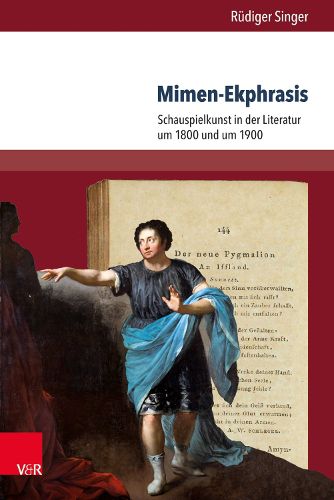Readings Newsletter
Become a Readings Member to make your shopping experience even easier.
Sign in or sign up for free!
You’re not far away from qualifying for FREE standard shipping within Australia
You’ve qualified for FREE standard shipping within Australia
The cart is loading…






English summary: Posterity weaves no garlands to the mime: This lament by Friedrich Schiller has been contradicted since the 18th century by a largely neglected body of texts striving to re-enact the art of great actors in the reader’s imagination. Using the term mime-ekphrasis, these texts are situated both in the antique tradition of vivid descriptions and in the context since the 18th century descriptions of art marked by a growing fascination with the intricate relations between the Sister Arts of poetry and painting. This study bridges intermedial, performance and visual culture studies to reveal how the scenic structure of ekphrasis interacts with the plurimedial character of acting, in English, German, and Italian ekphrases on Burbage, Garrick, Iffland, Talma, Kainz, Duse, et al. German description: Dem Mimen flicht die Nachwelt keine Kranze Im Widerspruch zu Schillers Behauptung entstanden seit dem 18. Jahrhundert zahlreiche Vers- und Prosatexte mit dem Anspruch, die Kunst grosser Mimen zu vergegenwartigen. Der Begriff Mimen-Ekphrasis stellt die Gattung einerseits in die rhetorische Tradition lebendiger Beschreibungskunst; andererseits wird sie als Sonderform von Kunstbeschreibung im Zeichen der Diskussion von Wort-Bild-Beziehungen im 18. Jahrhundert interpretiert. Intermedialitatsforschung, Bildwissenschaft und Performances Studies verbindend zeigt Rudiger Singer auf, wie die szenische Struktur von Ekphrasen mit der plurimedialen Verfasstheit von Schauspielkunst interagiert. Untersucht werden englische, deutsche und italienische Texte u.a. uber Garrick, Iffland, Talma, Kainz und die Duse.
$9.00 standard shipping within Australia
FREE standard shipping within Australia for orders over $100.00
Express & International shipping calculated at checkout
English summary: Posterity weaves no garlands to the mime: This lament by Friedrich Schiller has been contradicted since the 18th century by a largely neglected body of texts striving to re-enact the art of great actors in the reader’s imagination. Using the term mime-ekphrasis, these texts are situated both in the antique tradition of vivid descriptions and in the context since the 18th century descriptions of art marked by a growing fascination with the intricate relations between the Sister Arts of poetry and painting. This study bridges intermedial, performance and visual culture studies to reveal how the scenic structure of ekphrasis interacts with the plurimedial character of acting, in English, German, and Italian ekphrases on Burbage, Garrick, Iffland, Talma, Kainz, Duse, et al. German description: Dem Mimen flicht die Nachwelt keine Kranze Im Widerspruch zu Schillers Behauptung entstanden seit dem 18. Jahrhundert zahlreiche Vers- und Prosatexte mit dem Anspruch, die Kunst grosser Mimen zu vergegenwartigen. Der Begriff Mimen-Ekphrasis stellt die Gattung einerseits in die rhetorische Tradition lebendiger Beschreibungskunst; andererseits wird sie als Sonderform von Kunstbeschreibung im Zeichen der Diskussion von Wort-Bild-Beziehungen im 18. Jahrhundert interpretiert. Intermedialitatsforschung, Bildwissenschaft und Performances Studies verbindend zeigt Rudiger Singer auf, wie die szenische Struktur von Ekphrasen mit der plurimedialen Verfasstheit von Schauspielkunst interagiert. Untersucht werden englische, deutsche und italienische Texte u.a. uber Garrick, Iffland, Talma, Kainz und die Duse.